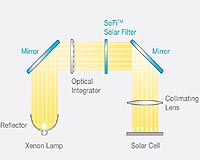 |
Hamilton, Canada (SPX) Jun 16, 2009 There won't be anymore waiting in the dark at this campus bus shelter. New flexible solar cell technology developed by a group of engineering researchers at McMaster University has been installed to power lighting for night-time transit users. The researchers are also hoping that the prototype will help boost efforts to commercialize the new technology. The bus shelter is located on the west side of University Avenue between the John Hodgins Engineering Building and the Life Sciences Building. "Our goal is to provide a clean, affordable power source for bus shelters that will let transit companies run Internet-based scheduling updates," said Adrian Kitai, a professor of engineering physics at McMaster who guided the project. "The solar technology can also be used to light up bus shelter signage and provide lighting for general safety." The flexible solar cell project started as a master's thesis for Wei Zhang, who subsequently worked as an engineer in the Department of Engineering Physics. Julia Zhu, a research technician in the department, and Jesika Briones, a master's of engineering entrepreneurship and innovation graduate, also helped develop the initiative. The ability to bend the solar cells to fit the curved roof of the bus shelter is one of the main features of the technology. The flexibility is achieved by tiling a large number of small silicon elements into an array, mounting them onto a flexible sheet, and connecting them through a proprietary method. The two solar strips installed on the McMaster bus shelter are about 90 centimeters long and 12 centimeters wide. Each strip has 720 one-centimetre square solar cells and generates up to 4.5 Watts of power. With the help of Facility Services at McMaster, a solar strip was mounted at each end of the bus shelter roof and connected to two energy-efficient, multi-LED, light fixtures. Each light fixture uses only 600 milliwatts of power and produces about the same light output as a three watt regular tungsten bulb or what a small night light would use. The lights are bright enough for easy reading. The solar cells capture sunlight during the day and convert it to electricity to recharge batteries located in each lighting unit. The batteries can hold enough charge to light the shelter for the better part of a night. The solar cell research team is monitoring the installation to determine how much solar power is required to fully recharge the batteries based on weather conditions. Winter months will be a particular focus as shorter and overcast days, snow and cold can affect the charging ability of the solar cells and batteries. Funding for the initiative was provided through an NSERC strategic grant and an NSERC I2I grant. Share This Article With Planet Earth
Related Links McMaster University All About Solar Energy at SolarDaily.com
 Sofi Solar Filter Satisfies Most Rigorous Requirements
Sofi Solar Filter Satisfies Most Rigorous RequirementsBalzers, Liechtenstein (SPX) Jun 15, 2009 Global growth in solar energy production has boosted demand for photovoltaic applications and massively increased the related requirements. In response to the needs of this market of the future, Optics Balzers has developed interference filters satisfying the most rigorous customer-specific requirements, for example for sun simulators. Thanks to the company's years of experience, these ... read more |
|
| The content herein, unless otherwise known to be public domain, are Copyright 1995-2009 - SpaceDaily. AFP and UPI Wire Stories are copyright Agence France-Presse and United Press International. ESA Portal Reports are copyright European Space Agency. All NASA sourced material is public domain. Additional copyrights may apply in whole or part to other bona fide parties. Advertising does not imply endorsement,agreement or approval of any opinions, statements or information provided by SpaceDaily on any Web page published or hosted by SpaceDaily. Privacy Statement |